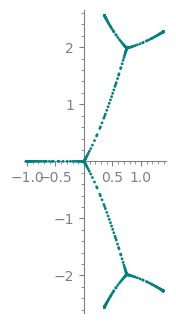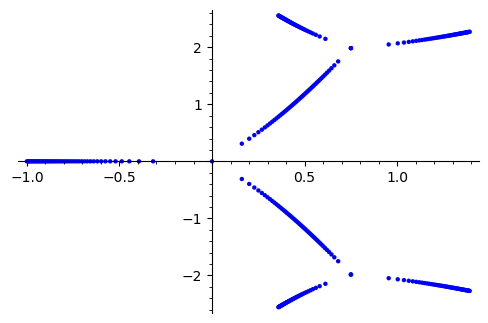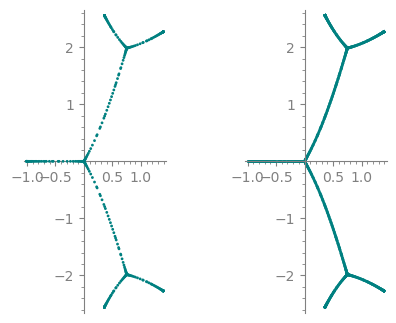Revision history [back]
 | 1 | initial version |
Are you working on dessins d'enfants ?
Here is a simple idea for an approximate plot
sage: x = polygen(QQ, 'x')
sage: f = 1/729*(2*x**2-3*x+9)**3*(x+1)
sage: N = 50
sage: sum(point2d(root) for k in range(N+1) for root in (f - k / N).complex_roots())
 | 2 | No.2 Revision |
Are you working on dessins d'enfants ?d'enfants?
Here is a simple idea for an approximate plotplot.
sage: x = polygen(QQ, 'x')
sage: f = 1/729*(2*x**2-3*x+9)**3*(x+1)
sage: N = 50
sage: sum(point2d(root) point2d(root for k in range(N+1) for root in (f - k / N).complex_roots())
The function pre01 below builds on this idea.
It gives a good idea of the desired plot and runs very fast.
def pre01(f, n=50, **opt):
r"""
Return the preimage of the unit interval under this rational function.
INPUT:
- ``f`` -- a rational function
- ``n`` -- optional (default: 50) -- roughly how many points
in the unit interval [0, 1] to use for preparing the plot
Roughly a third or the points are inverse powers of two,
roughly a third are one minus inverse powers of two,
and roughly a third are linearly spaced along the interval.
EXAMPLES::
sage: x = polygen(QQ, 'x')
sage: f = 1/729 * (2 * x**2 - 3 * x + 9)**3 * (x + 1)
sage: pre01(f, n=50, color='teal').show(figsize=5)
sage: z = polygen(QQ, 'z')
sage: num = -(z^4-6*z^3+12*z^2-8*z)*(z-1)^3*(z-3)
sage: den = (2*z-3)*(z-2)^3*z
sage: pre01(num/den, n=50, color='steelblue').show(figsize=7)
sage: Qz.<z> = QQ[]
sage: cc = [81, -432, 972, -1200, 886, -400, 108, -16, 1]
sage: num = -Qz(cc)*(z-2)^6*(z-4)*z
sage: den = (6*z^4-48*z^3+140*z^2-176*z+81)*(z-1)^4*(z-3)^4
sage: pre01(num/den, n=50, color='firebrick').show(figsize=7)
"""
nn = n // 3 + 2
num, den = f.numerator(), f.denominator()
tt = [0] + [ZZ(2)**-k for k in (0 .. nn)]
tt.extend([1 - t for t in tt[3:]])
tt.extend(QQ((k, nn)) for k in (1 .. nn - 1))
zz = (root for t in set(tt) for root in (num - t*den).complex_roots())
cols = {'color': 'teal', 'axes_color': 'grey',
'axes_label_color': 'grey', 'tick_label_color': 'grey'}
op = {'size': 4, 'color': 'teal', 'zorder': 3, 'aspect_ratio': 1}
for k, v in opt.items():
if 'color' in k:
cols[k] = v
else
op[k] = v
G = point2d(zz, color=cols['color'] **op)
G.axes_color(cols['axes_color'])
G.axes_label_color(cols['axes_label_color'])
G.tick_label_color(cols['tick_label_color'])
return G
Three examples of usage.
Our quick example from above:
x = polygen(QQ, 'x')
f = 1/729 * (2 * x**2 - 3 * x + 9)**3 * (x + 1)
p = pre01(f, n=50, color='teal')
p.show(figsize=5)

The first example in the question:
z = polygen(QQ, 'z')
num = -(z^4-6*z^3+12*z^2-8*z)*(z-1)^3*(z-3)
den = (2*z-3)*(z-2)^3*z
p = pre01(num/den, n=50, color='steelblue')
p.show(figsize=5)

The second example in the question:
z = polygen(QQ, 'z')
num = -(z^8-16*z^7+108*z^6-400*z^5+886*z^4-1200*z^3+972*z^2-432*z+81)*(z-2)^6*(z-4)*z
den = (6*z^4-48*z^3+140*z^2-176*z+81)*(z-1)^4*(z-3)^4
p = pre01(num/den, n=50, color='firebrick')
p.show(figsize=5)

Each of those three examples runs in under a second.
 | 3 | No.3 Revision |
Are you working on dessins d'enfants?
Here is a simple idea for an approximate plot.
sage: x = polygen(QQ, 'x')
sage: f = 1/729*(2*x**2-3*x+9)**3*(x+1)
sage: N = 50
sage: point2d(root for k in range(N+1) for root in (f - k / N).complex_roots())

The function pre01 below builds on this idea.
idea.
It gives a good idea of the desired plot and runs very fast.
def pre01(f, n=50, **opt):
r"""
Return the preimage of the unit interval under this rational function.
INPUT:
- ``f`` -- a rational function
- ``n`` -- optional (default: 50) -- roughly how many points
in the unit interval [0, 1] to use for preparing the plot
Roughly a third or the points are inverse powers of two,
roughly a third are one minus inverse powers of two,
and roughly a third are linearly spaced along the interval.
EXAMPLES::
sage: x = polygen(QQ, 'x')
sage: f = 1/729 * (2 * x**2 - 3 * x + 9)**3 * (x + 1)
sage: pre01(f, n=50, color='teal').show(figsize=5)
sage: z = polygen(QQ, 'z')
sage: num = -(z^4-6*z^3+12*z^2-8*z)*(z-1)^3*(z-3)
sage: den = (2*z-3)*(z-2)^3*z
sage: pre01(num/den, n=50, color='steelblue').show(figsize=7)
color='steelblue').show(figsize=5)
sage: Qz.<z> = QQ[]
sage: cc = [81, -432, 972, -1200, 886, -400, 108, -16, 1]
sage: num = -Qz(cc)*(z-2)^6*(z-4)*z
sage: den = (6*z^4-48*z^3+140*z^2-176*z+81)*(z-1)^4*(z-3)^4
sage: pre01(num/den, n=50, color='firebrick').show(figsize=7)
color='firebrick').show(figsize=5)
"""
nn = n // 3 + 2
num, den = f.numerator(), f.denominator()
tt = [0] + [ZZ(2)**-k for k in (0 .. nn)]
tt.extend([1 - t for t in tt[3:]])
tt.extend(QQ((k, nn)) for k in (1 .. nn - 1))
zz = (root for t in set(tt) for root in (num - t*den).complex_roots())
cols = {'color': 'teal', 'axes_color': 'grey',
'axes_label_color': 'grey', 'tick_label_color': 'grey'}
op = {'size': 4, 'color': 'teal', 'zorder': 3, 'aspect_ratio': 1}
for k, v in opt.items():
if 'color' in k:
cols[k] = v
else
else:
op[k] = v
G = point2d(zz, color=cols['color'] **op)
G.axes_color(cols['axes_color'])
G.axes_label_color(cols['axes_label_color'])
G.tick_label_color(cols['tick_label_color'])
return G
Three examples of usage.using this function follow.
Our quick example from above:
x = polygen(QQ, 'x')
f = 1/729 * (2 * x**2 - 3 * x + 9)**3 * (x + 1)
p = pre01(f, n=50, color='teal')
p.show(figsize=5)

The first example in the question:
z = polygen(QQ, 'z')
num = -(z^4-6*z^3+12*z^2-8*z)*(z-1)^3*(z-3)
den = (2*z-3)*(z-2)^3*z
p = pre01(num/den, n=50, color='steelblue')
p.show(figsize=5)

The second example in the question:
z = polygen(QQ, 'z')
num = -(z^8-16*z^7+108*z^6-400*z^5+886*z^4-1200*z^3+972*z^2-432*z+81)*(z-2)^6*(z-4)*z
den = (6*z^4-48*z^3+140*z^2-176*z+81)*(z-1)^4*(z-3)^4
p = pre01(num/den, n=50, color='firebrick')
p.show(figsize=5)

Each of those three examples runs in under a second.
 | 4 | No.4 Revision |
Are you working on dessins d'enfants?
Here is a simple idea for an approximate plot.
sage: x = polygen(QQ, 'x')
sage: f = 1/729*(2*x**2-3*x+9)**3*(x+1)
sage: N = 50
sage: point2d(root for k in range(N+1) for root in (f - k / N).complex_roots())

The function pre01 below builds on this idea.
It gives a good idea of the desired plot and runs fast.
def pre01(f, n=50, **opt):
r"""
Return the preimage of the unit interval under this rational function.
INPUT:
- ``f`` -- a rational function
- ``n`` -- optional (default: 50) -- roughly how many points
in the unit interval [0, 1] to use for preparing the plot
Roughly a third or the points are inverse powers of two,
roughly a third are one minus inverse powers of two,
and roughly a third are linearly spaced along the interval.
EXAMPLES::
sage: x = polygen(QQ, 'x')
sage: f = 1/729 * (2 * x**2 - 3 * x + 9)**3 * (x + 1)
sage: pre01(f, n=50, color='teal').show(figsize=5)
sage: z = polygen(QQ, 'z')
sage: num = -(z^4-6*z^3+12*z^2-8*z)*(z-1)^3*(z-3)
sage: den = (2*z-3)*(z-2)^3*z
sage: pre01(num/den, n=50, color='steelblue').show(figsize=5)
sage: Qz.<z> = QQ[]
sage: cc = [81, -432, 972, -1200, 886, -400, 108, -16, 1]
sage: num = -Qz(cc)*(z-2)^6*(z-4)*z
sage: den = (6*z^4-48*z^3+140*z^2-176*z+81)*(z-1)^4*(z-3)^4
sage: pre01(num/den, n=50, color='firebrick').show(figsize=5)
"""
nn = n // 3 + 2
num, den = f.numerator(), f.denominator()
tt = [0] + [ZZ(2)**-k for k in (0 .. nn)]
tt.extend([1 - t for t in tt[3:]])
tt.extend(QQ((k, nn)) for k in (1 .. nn - 1))
zz = (root for t in set(tt) for root in (num - t*den).complex_roots())
cols = {'color': 'teal', 'axes_color': 'grey',
'axes_label_color': 'grey', 'tick_label_color': 'grey'}
op = {'size': 4, 'color': 'teal', 'zorder': 3, 'aspect_ratio': 1}
for k, v in opt.items():
if 'color' in k:
cols[k] = v
else:
op[k] = v
G = point2d(zz, color=cols['color'] color=cols['color'], **op)
G.axes_color(cols['axes_color'])
G.axes_label_color(cols['axes_label_color'])
G.tick_label_color(cols['tick_label_color'])
return G
Three examples of using this function follow.
Our quick example from above:
x = polygen(QQ, 'x')
f = 1/729 * (2 * x**2 - 3 * x + 9)**3 * (x + 1)
p = pre01(f, n=50, color='teal')
p.show(figsize=5)

The first example in the question:
z = polygen(QQ, 'z')
num = -(z^4-6*z^3+12*z^2-8*z)*(z-1)^3*(z-3)
den = (2*z-3)*(z-2)^3*z
p = pre01(num/den, n=50, color='steelblue')
p.show(figsize=5)

The second example in the question:
z = polygen(QQ, 'z')
num = -(z^8-16*z^7+108*z^6-400*z^5+886*z^4-1200*z^3+972*z^2-432*z+81)*(z-2)^6*(z-4)*z
den = (6*z^4-48*z^3+140*z^2-176*z+81)*(z-1)^4*(z-3)^4
p = pre01(num/den, n=50, color='firebrick')
p.show(figsize=5)

Each of those three examples runs in under a second.
 | 5 | No.5 Revision |
Are you working on dessins d'enfants?
Here is a simple idea for an approximate plot.
sage: x = polygen(QQ, 'x')
sage: f = 1/729*(2*x**2-3*x+9)**3*(x+1)
sage: N = 50
sage: point2d(root for k in range(N+1) for root in (f - k / N).complex_roots())

The function pre01 below builds on this idea.
It gives a good idea of the desired plot and runs fast.
def pre01(f, n=50, style='dots', **opt):
r"""
Return the preimage of the unit interval under this rational function.
INPUT:
- ``f`` -- a rational function
- ``n`` -- optional (default: 50) -- roughly how many points
in the unit interval [0, 1] to use for preparing the plot
Roughly a third or the points are inverse powers of two,
roughly a third are one minus inverse powers of two,
and roughly a third are linearly spaced along the interval.
EXAMPLES::
sage: x = polygen(QQ, 'x')
sage: f = 1/729 * (2 * x**2 - 3 * x + 9)**3 * (x + 1)
sage: pre01(f, n=50, color='teal').show(figsize=5)
style='dots', color='firebrick').show(figsize=5)
sage: pre01(f, n=50, style='line', color='firebrick').show(figsize=5)
sage: z = polygen(QQ, 'z')
sage: num = -(z^4-6*z^3+12*z^2-8*z)*(z-1)^3*(z-3)
sage: den = (2*z-3)*(z-2)^3*z
sage: pre01(num/den, g = num/den
sage: pre01(g, n=50, color='steelblue').show(figsize=5)
style='dots', color='firebrick').show(figsize=5)
sage: pre01(g, n=50, style='line', color='firebrick').show(figsize=5)
sage: Qz.<z> = QQ[]
sage: cc = [81, -432, 972, -1200, 886, -400, 108, -16, 1]
sage: num = -Qz(cc)*(z-2)^6*(z-4)*z
sage: den = (6*z^4-48*z^3+140*z^2-176*z+81)*(z-1)^4*(z-3)^4
sage: pre01(num/den, h = num/den
sage: pre01(h, n=50, style='dots', color='firebrick').show(figsize=5)
sage: pre01(h, n=50, style='line', color='firebrick').show(figsize=5)
"""
nn = n // 3 + 2
num, den = f.numerator(), f.denominator()
tt = [0] + [ZZ(2)**-k for k in (0 .. nn)]
tt.extend([1 - t for t in tt[3:]])
tt.extend(QQ((k, nn)) for k in (1 .. nn - 1))
zz = (root for t in set(tt) for root in (num - t*den).complex_roots())
tt = sorted(set(tt))
cols = {'color': 'teal', 'axes': True, 'axes_color': 'grey',
'axes_label_color': 'grey', 'tick_label_color': 'grey'}
op = {'size': dop = {'aspect_ratio': 1, 'size': 4, 'color': 'teal', 'zorder': 3, 'aspect_ratio': 1}
10}
lop = {'aspect_ratio': 1, 'edge_thickness': 2}
for k, v in opt.items():
if 'color' in k or 'axis' in k or 'axes' in k or 'tick' in k:
cols[k] = v
elif k == 'size':
dop[k] = v
elif k == 'edge_thickness':
lop[k] = v
else:
op[k] dop[k] = lop[k] = v
if style == 'dots':
zz = (root for t in set(tt) for root in (num - t*den).complex_roots())
G = point2d(zz, color=cols['color'], **op)
**dop)
elif style == 'line':
tzz = {t: (num - t*den).complex_roots() for t in tt}
D = Graph()
for k, t in enumerate(tt[1:-1], start=1):
s, u = tt[k-1], tt[k+1]
szz, uzz = tzz[s], tzz[u]
for z in tzz[t]:
zs = min((abs(z - w), w) for w in szz)[1]
D.add_edge(z, zs, k-1)
zu = min((abs(z - w), w) for w in uzz)[1]
D.add_edge(z, zu, k)
D.set_pos({z: (z.real(), z.imag()) for z in D})
ecol = {cols['color']: D.edges()}
G = D.plot(vertex_labels=False, vertex_size=0, edge_colors=ecol, **lop)
else:
raise ValueError(f"style should be 'dots' or 'line', got :'{style}'")
G.axes(cols['axes'])
G.axes_color(cols['axes_color'])
G.axes_label_color(cols['axes_label_color'])
G.tick_label_color(cols['tick_label_color'])
return G
Three examples of using this function follow.
Our quick Quick starting example from above:of this answer:
x = polygen(QQ, 'x')
f = 1/729 * (2 * x**2 - 3 * x + 9)**3 * (x + 1)
p a_dots = pre01(f, n=50, style='dots, color='teal')
p.show(figsize=5)
a_line = pre01(f, n=50, style='line', color='teal')
a_dots_lines = graphics_array([a_dots, a_line], ncols=2)
a_dots_lines.show(figsize=5)


The first First example in the question:
z = polygen(QQ, 'z')
num = -(z^4-6*z^3+12*z^2-8*z)*(z-1)^3*(z-3)
den = (2*z-3)*(z-2)^3*z
p b_dots = pre01(num/den, n=50, style='dots', color='steelblue')
p.show(figsize=5)
b_line = pre01(num/den, n=50, style='line', color='steelblue')
b_dots_lines = graphics_array([b_dots, b_line], ncols=1)
b_dots_lines.show(figsize=5)


The second Second example in the question:
z = polygen(QQ, 'z')
num = -(z^8-16*z^7+108*z^6-400*z^5+886*z^4-1200*z^3+972*z^2-432*z+81)*(z-2)^6*(z-4)*z
den = (6*z^4-48*z^3+140*z^2-176*z+81)*(z-1)^4*(z-3)^4
p c_dots = pre01(num/den, n=50, style='dots', color='firebrick')
p.show(figsize=5)
c_line = pre01(num/den, n=50, style='line', color='firebrick')
c_dots_lines = graphics_array([c_dots, c_line], ncols=1)
c_dots_lines.show(figsize=5)


Each of those three examples runs in under a second.second per plot style.
 | 6 | No.6 Revision |
Are you working on dessins d'enfants?
Here is a simple idea for an approximate plot.
sage: x = polygen(QQ, 'x')
sage: f = 1/729*(2*x**2-3*x+9)**3*(x+1)
sage: N = 50
sage: point2d(root for k in range(N+1) for root in (f - k / N).complex_roots())

The function pre01 below builds on this idea.
It gives a good idea of the desired plot and runs fast.
def pre01(f, n=50, style='dots', **opt):
r"""
Return the preimage of the unit interval under this rational function.
INPUT:
- ``f`` -- a rational function
- ``n`` -- optional (default: 50) -- roughly how many points
in the unit interval [0, 1] to use for preparing the plot
Roughly a third or the points are inverse powers of two,
roughly a third are one minus inverse powers of two,
and roughly a third are linearly spaced along the interval.
EXAMPLES::
sage: x = polygen(QQ, 'x')
sage: f = 1/729 * (2 * x**2 - 3 * x + 9)**3 * (x + 1)
sage: pre01(f, n=50, style='dots', color='firebrick').show(figsize=5)
sage: pre01(f, n=50, style='line', color='firebrick').show(figsize=5)
sage: z = polygen(QQ, 'z')
sage: num = -(z^4-6*z^3+12*z^2-8*z)*(z-1)^3*(z-3)
sage: den = (2*z-3)*(z-2)^3*z
sage: g = num/den
sage: pre01(g, n=50, style='dots', color='firebrick').show(figsize=5)
sage: pre01(g, n=50, style='line', color='firebrick').show(figsize=5)
sage: Qz.<z> = QQ[]
sage: cc = [81, -432, 972, -1200, 886, -400, 108, -16, 1]
sage: num = -Qz(cc)*(z-2)^6*(z-4)*z
sage: den = (6*z^4-48*z^3+140*z^2-176*z+81)*(z-1)^4*(z-3)^4
sage: h = num/den
sage: pre01(h, n=50, style='dots', color='firebrick').show(figsize=5)
sage: pre01(h, n=50, style='line', color='firebrick').show(figsize=5)
"""
nn = n // 3 + 2
num, den = f.numerator(), f.denominator()
tt = [0] + [ZZ(2)**-k for k in (0 .. nn)]
tt.extend([1 - t for t in tt[3:]])
tt.extend(QQ((k, nn)) for k in (1 .. nn - 1))
tt = sorted(set(tt))
cols = {'color': 'teal', 'axes': True, 'axes_color': 'grey',
'axes_label_color': 'grey', 'tick_label_color': 'grey'}
dop = {'aspect_ratio': 1, 'size': 4, 'zorder': 10}
lop = {'aspect_ratio': 1, 'edge_thickness': 2}
for k, v in opt.items():
if 'color' in k or 'axis' in k or 'axes' in k or 'tick' in k:
cols[k] = v
elif k == 'size':
dop[k] = v
elif k == 'edge_thickness':
lop[k] = v
else:
dop[k] = lop[k] = v
if style == 'dots':
zz = (root for t in set(tt) for root in (num - t*den).complex_roots())
G = point2d(zz, color=cols['color'], **dop)
elif style == 'line':
tzz = {t: (num - t*den).complex_roots() for t in tt}
D = Graph()
for k, t in enumerate(tt[1:-1], start=1):
s, u = tt[k-1], tt[k+1]
szz, uzz = tzz[s], tzz[u]
for z in tzz[t]:
zs = min((abs(z - w), w) for w in szz)[1]
D.add_edge(z, zs, k-1)
zu = min((abs(z - w), w) for w in uzz)[1]
D.add_edge(z, zu, k)
D.set_pos({z: (z.real(), z.imag()) for z in D})
ecol = {cols['color']: D.edges()}
G = D.plot(vertex_labels=False, vertex_size=0, edge_colors=ecol, **lop)
else:
raise ValueError(f"style should be 'dots' or 'line', got :'{style}'")
G.axes(cols['axes'])
G.axes_color(cols['axes_color'])
G.axes_label_color(cols['axes_label_color'])
G.tick_label_color(cols['tick_label_color'])
return G
Three examples of using this function follow.
Quick starting example of this answer:
x = polygen(QQ, 'x')
f = 1/729 * (2 * x**2 - 3 * x + 9)**3 * (x + 1)
a_dots = pre01(f, n=50, style='dots, style='dots', color='teal')
a_line = pre01(f, n=50, style='line', color='teal')
a_dots_lines = graphics_array([a_dots, a_line], ncols=2)
a_dots_lines.show(figsize=5)

First example in the question:
z = polygen(QQ, 'z')
num = -(z^4-6*z^3+12*z^2-8*z)*(z-1)^3*(z-3)
den = (2*z-3)*(z-2)^3*z
b_dots = pre01(num/den, n=50, style='dots', color='steelblue')
b_line = pre01(num/den, n=50, style='line', color='steelblue')
b_dots_lines = graphics_array([b_dots, b_line], ncols=1)
b_dots_lines.show(figsize=5)

Second example in the question:
z = polygen(QQ, 'z')
num = -(z^8-16*z^7+108*z^6-400*z^5+886*z^4-1200*z^3+972*z^2-432*z+81)*(z-2)^6*(z-4)*z
den = (6*z^4-48*z^3+140*z^2-176*z+81)*(z-1)^4*(z-3)^4
c_dots = pre01(num/den, n=50, style='dots', color='firebrick')
c_line = pre01(num/den, n=50, style='line', color='firebrick')
c_dots_lines = graphics_array([c_dots, c_line], ncols=1)
c_dots_lines.show(figsize=5)

Each of those three examples runs in under a second per plot style.

